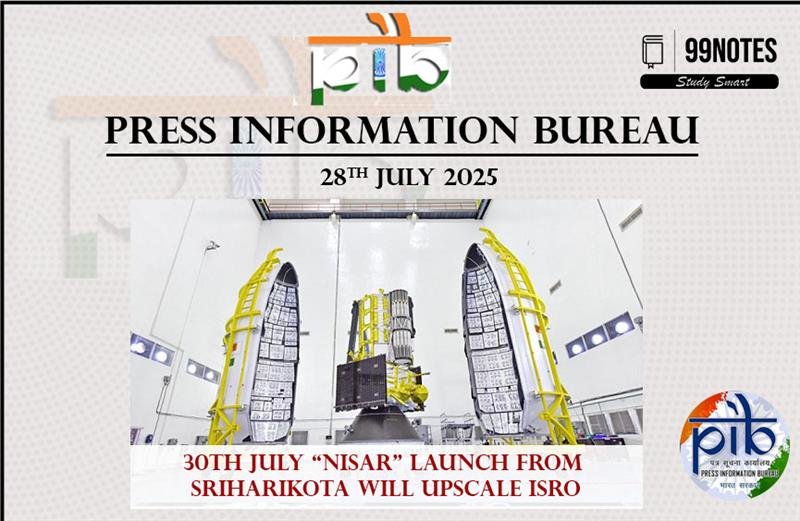28 July 2025: PIB Summary For UPSC
1. 30th July “NISAR” launch from Sriharikota will upscale ISRO’s international collaborations
Source – Press Information Bureau (PIB) – Ministry of Jal Shakti (28 July 2025)
|
Topic: GS 3: Science and Technology; Disaster Management; Environmental Monitoring |
|
Context |
|
Content:
Introduction
Union Minister Dr Jitendra Singh referred to NISAR as a “global benchmark for Indo‑US scientific collaboration” and “India’s scientific handshake with the world” Built jointly by ISRO and NASA, it’s slated to launch aboard GSLV‑F16 from Sriharikota.
Key Features & Technological Aspects
-
Dual‑frequency Synthetic Aperture Radar (SAR):
-
L‑band radar contributed by NASA
-
S‑band radar provided by ISRO
-
Unified on a 12 m unfurlable reflector mounted on ISRO’s I‑3K bus.
-
-
Payload & Orbit:
-
Launch mass: ~2,392 kg
-
Placed into a sun‑synchronous polar orbit at ~743 km, inclination ~98.4°
-
First GSLV launch into sun‑synchronous orbit, showcasing advanced ISRO capability.
-
-
Imaging Technology – SweepSAR:
-
Wide swath (~242 km) with high resolution (5–100 m)
-
Offers all‑weather, day‑and‑night imagery globally every 12 days.
-
Applications & Benefits
-
Disaster & Environmental Monitoring:
-
Tracks land deformation, seismic activity, tsunamis, volcanoes, landslides, subsidence uplift
-
Detects changes in ice sheets, glaciers, wetlands, and coastal shorelines
-
Supports crop mapping, soil moisture, forestry, biomass quantification, sea‑ice and ship detection
-
-
Data Access & Democratization:
-
Data to be freely available globally within 1–2 days; near real‑time during emergencies
-
Encourages inclusive use by developing nations, researchers, and disaster agencies
-
-
Strategic & Global Significance:
-
Signal of matured Indo‑US science diplomacy
-
Aligned with PM’s vision of India as “Vishwa Bandhu”, reinforcing India’s role as a knowledge-provider to the global community
-
Analytical Perspective
Technological Leap
-
Integrating dual‑band radar (NASA L‑band, ISRO S‑band) on a single platform enhances precision and resilience in imaging—critical for varied geographical conditions.
Strategic Diplomacy
-
Reflects deepened India‑US civil space cooperation, enhancing geostrategic partnerships through science.
Climate Change & Disaster Preparedness
-
Critical for climate resilience and SDG‑aligned goals, it underpins early-warning systems for natural hazards; supports management of water, forests, agriculture, and glacier domains.
Challenges
-
Mission delays due to hardware modifications underscore the complexity of international collaboration. Ensuring sustained data quality and processing remains vital.
Way Forward
NISAR is a pioneering mission that elevates India’s space capability and global scientific outreach. For sustained impact:
-
Strengthen data processing infrastructure and user access portals
-
Promote active global partnerships in research and disaster management
-
Derive actionable insights from data for national planning—especially in sectors like agriculture, water resources, and climate resilience
|
Practice Question: “Discuss the significance of the NASA‑ISRO NISAR satellite mission in enhancing India’s space technology capabilities and international scientific collaboration. How will its free data policy impact global efforts in disaster resilience and environmental monitoring?” |
Check this out 26 July 2025: PIB Summary For UPSC



